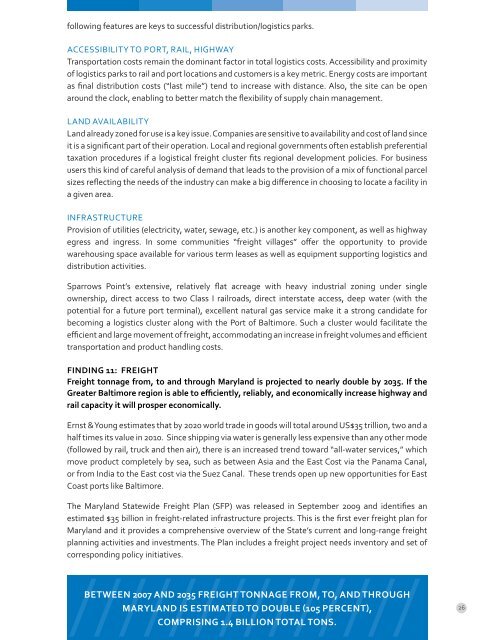COMMON GROUND
You also want an ePaper? Increase the reach of your titles
YUMPU automatically turns print PDFs into web optimized ePapers that Google loves.
following features are keys to successful distribution/logistics parks.<br />
ACCESSIBILITY TO PORT, RAIL, HIGHWAY<br />
Transportation costs remain the dominant factor in total logistics costs. Accessibility and proximity<br />
of logistics parks to rail and port locations and customers is a key metric. Energy costs are important<br />
as final distribution costs (“last mile”) tend to increase with distance. Also, the site can be open<br />
around the clock, enabling to better match the flexibility of supply chain management.<br />
LAND AVAILABILITY<br />
Land already zoned for use is a key issue. Companies are sensitive to availability and cost of land since<br />
it is a significant part of their operation. Local and regional governments often establish preferential<br />
taxation procedures if a logistical freight cluster fits regional development policies. For business<br />
users this kind of careful analysis of demand that leads to the provision of a mix of functional parcel<br />
sizes reflecting the needs of the industry can make a big difference in choosing to locate a facility in<br />
a given area.<br />
INFRASTRUCTURE<br />
Provision of utilities (electricity, water, sewage, etc.) is another key component, as well as highway<br />
egress and ingress. In some communities “freight villages” offer the opportunity to provide<br />
warehousing space available for various term leases as well as equipment supporting logistics and<br />
distribution activities.<br />
Sparrows Point’s extensive, relatively flat acreage with heavy industrial zoning under single<br />
ownership, direct access to two Class I railroads, direct interstate access, deep water (with the<br />
potential for a future port terminal), excellent natural gas service make it a strong candidate for<br />
becoming a logistics cluster along with the Port of Baltimore. Such a cluster would facilitate the<br />
efficient and large movement of freight, accommodating an increase in freight volumes and efficient<br />
transportation and product handling costs.<br />
FINDING 11: FREIGHT<br />
Freight tonnage from, to and through Maryland is projected to nearly double by 2035. If the<br />
Greater Baltimore region is able to efficiently, reliably, and economically increase highway and<br />
rail capacity it will prosper economically.<br />
Ernst & Young estimates that by 2020 world trade in goods will total around US$35 trillion, two and a<br />
half times its value in 2010. Since shipping via water is generally less expensive than any other mode<br />
(followed by rail, truck and then air), there is an increased trend toward “all-water services,” which<br />
move product completely by sea, such as between Asia and the East Cost via the Panama Canal,<br />
or from India to the East cost via the Suez Canal. These trends open up new opportunities for East<br />
Coast ports like Baltimore.<br />
The Maryland Statewide Freight Plan (SFP) was released in September 2009 and identifies an<br />
estimated $35 billion in freight-related infrastructure projects. This is the first ever freight plan for<br />
Maryland and it provides a comprehensive overview of the State’s current and long-range freight<br />
planning activities and investments. The Plan includes a freight project needs inventory and set of<br />
corresponding policy initiatives.<br />
//////////////<br />
BETWEEN 2007 AND 2035 FREIGHT TONNAGE FROM, TO, AND THROUGH<br />
MARYLAND IS ESTIMATED TO DOUBLE (105 PERCENT),<br />
COMPRISING 1.4 BILLION TOTAL TONS.<br />
26



